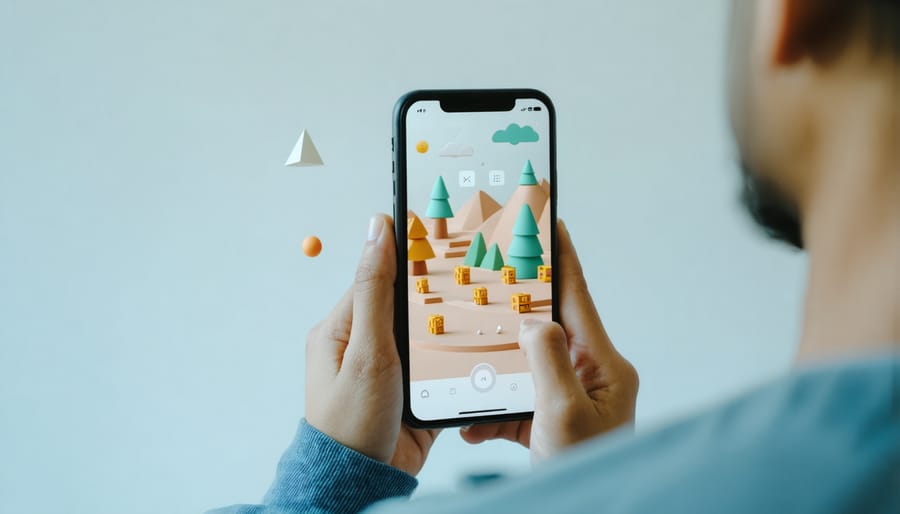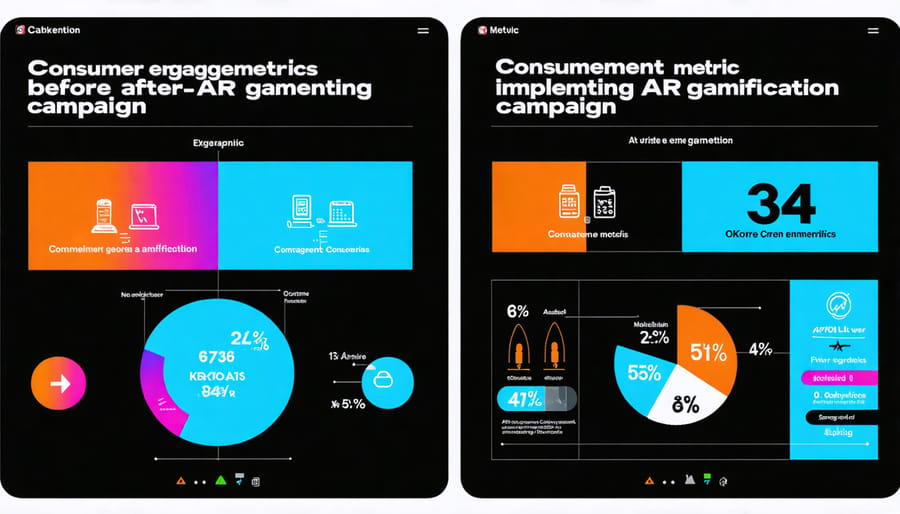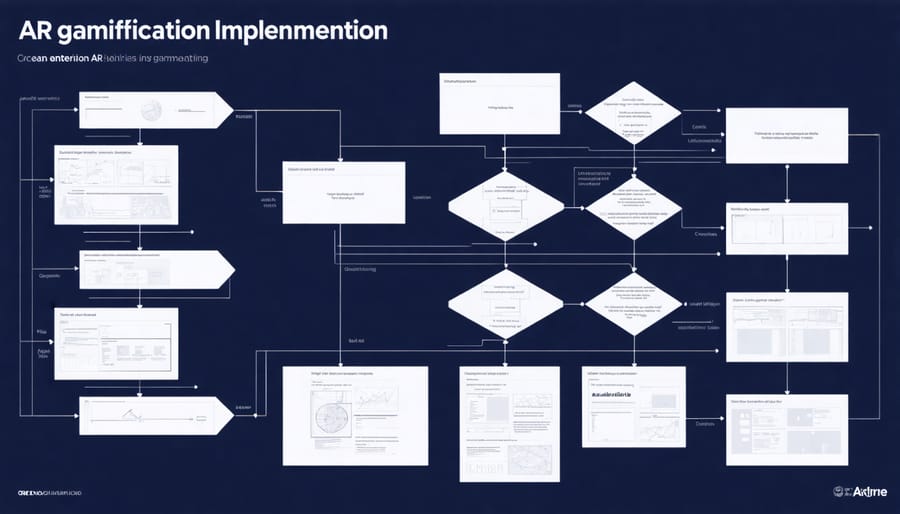AR Gamification: The Secret Weapon That’s Revolutionizing Marketing ROI

Gamification marketing revolutionizes traditional advertising by transforming passive consumers into active participants through game-like elements and mechanics. This powerful strategy, which has helped major brands increase engagement by up to 100-150%, integrates points, badges, leaderboards, and challenges into marketing campaigns to drive measurable results. As businesses increasingly leverage how AR transform customer experience, gamification emerges as a crucial tool for creating immersive, interactive brand experiences that boost customer loyalty and conversion rates.
The psychological principles behind gamification tap into fundamental human desires for achievement, competition, and reward, making it particularly effective for modern digital marketing campaigns. By incorporating game design elements into marketing strategies, businesses can create engaging experiences that not only capture attention but also motivate specific consumer behaviors, from social sharing to repeat purchases.
In today’s competitive digital landscape, understanding and implementing gamification marketing isn’t just advantageous—it’s becoming essential for brands seeking to stand out and create meaningful connections with their target audience. This approach transforms traditional marketing metrics into interactive challenges that resonate with consumers while delivering measurable business results.
What Makes AR Gamification Marketing Different
Core Elements of AR Gamification
AR gamification in marketing combines several essential components that work together to create engaging customer experiences. The interactive elements form the foundation, allowing users to actively participate rather than passively consume content. These elements typically include touchpoints where customers can manipulate virtual objects, solve puzzles, or complete challenges within their real environment using their mobile devices.
A well-structured rewards system serves as the motivation engine, encouraging continued engagement. This can include points, badges, virtual currencies, or exclusive content that users unlock through participation. The key is to ensure rewards are meaningful and align with customer interests, whether they’re discount codes, early access to products, or special recognition within the community.
Progress tracking mechanisms help maintain user engagement by showing advancement toward goals. This might include achievement levels, completion percentages, or leaderboards that foster healthy competition. Effective progress tracking should be transparent and easily accessible, giving users clear visibility of their journey and upcoming milestones.
The AR integration ties these elements together by overlaying digital content onto the real world. This could manifest as virtual try-ons for products, interactive store displays, or location-based challenges that blend physical and digital experiences. The AR component should enhance the natural shopping journey rather than complicate it.
For successful implementation, these core elements must work seamlessly together while remaining intuitive for users. The best AR gamification experiences maintain a balance between challenge and achievement, ensuring customers stay engaged without feeling frustrated or overwhelmed. Regular updates and fresh content keep the experience dynamic and encourage long-term participation.

The Psychology Behind AR Gaming Elements
The psychological impact of AR gamification in marketing taps into fundamental human motivations and behavioral patterns that drive engagement and action. When businesses implement effective AR customer engagement strategies, they activate key psychological triggers that make their marketing more compelling and memorable.
At its core, AR gamification leverages the reward system in our brains by providing immediate feedback and gratification. When customers interact with AR elements, their actions trigger dopamine releases, creating positive associations with the brand. This psychological mechanism is similar to what makes traditional games addictive, but it’s channeled into meaningful marketing interactions.
Three primary psychological principles make AR gamification particularly effective:
1. Achievement Motivation: AR elements that include progress tracking, levels, or collectibles tap into our natural desire to complete tasks and achieve goals.
2. Social Proof: When AR experiences are shareable, they leverage our inherent need for social validation and community participation.
3. Cognitive Engagement: Interactive AR elements require active participation, leading to deeper information processing and stronger memory formation.
The success of AR gamification also relies on the principle of variable rewards, where unpredictable positive outcomes maintain user interest longer than fixed rewards. This explains why AR treasure hunts and discovery-based campaigns often generate higher engagement rates than traditional marketing approaches.
Understanding these psychological foundations helps marketers design more effective AR experiences that naturally align with how customers think and behave, resulting in more engaging and successful campaigns.
Real-World Applications in Marketing Campaigns

Retail Success Stories
Several retail brands have demonstrated remarkable virtual reality marketing success through gamification strategies. Nike’s SNKRS app incorporated a treasure hunt-style game that increased engagement by 48% and boosted sales of limited-edition sneakers by 32% in the first quarter after launch.
Sephora’s Virtual Artist app, which gamified makeup testing through AR, resulted in a 25% increase in mobile app purchases and reduced return rates by 17%. The interactive experience allowed customers to experiment with different looks while earning points and unlocking exclusive products, leading to a 45% increase in customer engagement time.
Starbucks’ highly successful Rewards program demonstrates gamification at scale, with features like Star Dashes and Bonus Star Challenges driving a 7% year-over-year increase in active membership and contributing to 40% of all U.S. sales. The program’s game-like elements encouraged repeat visits and larger purchases.
Target’s Circle Rewards program implemented gaming elements like progress bars and achievement badges, resulting in a 30% increase in customer participation rates. The program’s success led to a 20% increase in average transaction value among participating customers, proving that simple gamification elements can significantly impact retail performance.
These examples showcase how gamification can transform traditional retail experiences into engaging, measurable marketing success stories.
Brand Awareness Campaigns
Brand awareness campaigns powered by AR gamification have revolutionized how companies connect with their target audience. Major brands like Pokemon GO and Snapchat have demonstrated the powerful impact of combining gaming elements with augmented reality to create memorable brand experiences.
Companies are increasingly using AR games to build brand recognition through interactive experiences. For example, Nike created an AR scavenger hunt that allowed customers to discover and purchase limited-edition sneakers, while Burger King’s “Burn That Ad” campaign encouraged users to virtually “burn” competitors’ ads to receive free hamburgers.
These campaigns work by leveraging several key elements:
– Interactive storytelling that puts the brand message in an engaging context
– Location-based features that drive foot traffic to physical stores
– Social sharing components that amplify reach organically
– Reward systems that incentivize continued engagement
– Real-time analytics to measure campaign effectiveness
Small and medium-sized businesses can also implement AR brand awareness campaigns through existing platforms. Social media filters, AR product visualization, and gamified loyalty programs are cost-effective entry points that don’t require extensive development resources.
The key to success lies in aligning the game mechanics with your brand values and ensuring the experience adds genuine value for users. Whether through educational content, entertainment, or exclusive rewards, the gaming elements should enhance rather than overshadow your brand message.
Implementation Strategy

Technical Requirements
To successfully implement gamification marketing with AR technology, businesses need specific tools and platforms that enable seamless integration and user engagement. At the core, you’ll need a robust AR development platform like Unity or Unreal Engine, which serves as the foundation for creating interactive experiences. These platforms support your AR marketing implementation by providing essential development tools and features.
Cloud infrastructure is crucial for hosting AR content and managing user data. Services like AWS or Google Cloud Platform offer scalable solutions that can handle increasing user demands. You’ll also need AR-specific software development kits (SDKs) such as Vuforia or ARKit for iOS devices and ARCore for Android platforms.
For tracking and analytics, implement tools like Google Analytics for AR or Mixpanel to measure user engagement and campaign performance. Content management systems (CMS) designed for AR experiences help maintain and update content without requiring technical expertise. Finally, ensure you have adequate mobile device testing capabilities and quality assurance tools to deliver smooth user experiences across different devices and operating systems.
Campaign Planning Process
To create an effective AR gamified marketing campaign, follow these essential planning steps. Begin by clearly defining your campaign objectives and target audience. This helps ensure your gamification elements align with your marketing goals and resonate with your intended users.
Next, develop your game mechanics and storyline. Consider what type of engagement you want to foster – whether it’s collecting virtual items, completing challenges, or earning rewards. Your game elements should naturally integrate with your brand message and product offerings.
Design your technical requirements and user interface. Ensure the AR experience is intuitive and accessible across different devices. Consider factors like load times, graphics quality, and user controls. Partner with experienced AR developers if needed.
Create a comprehensive testing plan before launch. Test for technical issues, user experience, and engagement levels. Gather feedback from a small user group and make necessary adjustments.
Finally, develop your promotion strategy and success metrics. Plan how you’ll promote the campaign across various channels and determine key performance indicators (KPIs) to measure its effectiveness. Include metrics like user engagement, conversion rates, and social sharing statistics.
Remember to maintain flexibility in your planning to accommodate user feedback and technological constraints during implementation.
Gamification marketing represents a powerful tool for modern businesses seeking to enhance customer engagement and drive measurable results. By incorporating game elements into your marketing strategy, you can create memorable experiences that boost brand loyalty, increase user participation, and generate valuable customer data. The key benefits – including higher engagement rates, improved customer retention, and enhanced brand awareness – make gamification an invaluable addition to your marketing toolkit. Start small by implementing simple game mechanics in your existing campaigns, then gradually expand based on customer response and engagement metrics. Remember that successful gamification requires careful planning, clear objectives, and consistent monitoring of results. Take the first step today by identifying areas in your marketing strategy where game elements could create more engaging customer experiences and drive better business outcomes.
Leave a Reply